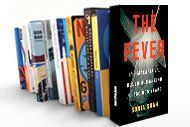
Sonia Shah
320 pages | Buy this book
Malaria kills a million people a year, most of them kids and pregnant women. Why can't we stop it? The Fever delves into both the scientific and historical reasons that the disease takes so many lives, and offers some surprising conclusions—including pointed criticisms of current relief efforts as "quick fixes." Plus, like the best infectious-disease lit, it's a real creepfest.
What's the Big Deal?
The Fever does for malaria what And The Band Played On did for HIV: it gives an extraordinary sense of the disease's historical sweep and devastating global impact. The malaria parasite rides in the salivary glands of mosquitoes, shape-shifting into different forms once it reaches the human body and mutating its way around treatments. Fighting it can seem like a Sisyphean task: it has killed more people than any other illness, ever.
Buzz Rating: Hum
Shah wrote a piece in the Los Angeles Times and NPR picked up on it, but otherwise this one may be under your radar. It's a good book on an important topic, but beach reading, it's not.
One-Breath Author Bio
An investigative journalist, Shah goes after the biggest and baddest: Her other books are The Body Hunters: Testing New Drugs on the World's Poorest Patients and Crude: The Story of Oil.
Don't Miss These Bits
1. How's this for a provocative argument? The worst disease in the history of humanity apparently has an upside: When it's not killing little black children, it kills white colonialist invaders. Look at page 35 where Shah quotes a TV journalist from Cameroon: "Channeling the nineteenth-century king of Madagascar who famously boasted that no invader could take on his country's hazo (impenetrable forests) or tazo (its malignant malarial fevers), he extolled 'General Anopheles' for thwarting the armies that would have attacked Africa." Then she gets dangerously close to endorsing this premise when she writes, "Not everyone living under P. falciparum's spell considers their situation an unmitigated misfortune . . . It isn't easy to live with malaria, but those who survive the gauntlet of a falciparum-infested childhood gain a powerful immunological advantage over others." True, but think of all the women and kids who don't survive.
2. Those crazy ancient Romans! Page 64 has a great list of the malaria "cures" that the war-hungry civilization of the early centuries engineered. There was the bedbug diet. (Or you could munch on "the liver of a seven-year-old mouse.") Wearing a necklace imprinted with the word "abracadabra" was once thought to stave off the disease. Or, everyone's favorite, period sex. Nothing worked, of course, but A for effort.
3. Green eggs and bugborne disease. During World War II, the military used pamphlets to educate soldiers about malaria. "This is Ann," one read, alongside a cartoon. "She drinks blood! Ann moves around at night (a real party gal) and she's got a thirst. No whiskey, gin, beer, or rum coke for Ann . . . " And so on. The tone makes marginally more sense when you learn the identity of the pamphlet's author: Dr. Seuss.
"It's the Next [Blank]!"
Given the gripping description of an infestation in a Panamanian village (page 7), it might as well be the next Outbreak.
Swipe This Critique
Shah has a thoughtful understanding of attitudes toward malaria among the African and Asian villagers who often fall victim to it. Unfortunately, this can make her sound biased against Western efforts to help, just because they're sponsored by the West. Shah is also plain wrong in saying that malaria control efforts are "the very opposite of locally tailored" (page 166); African governments have been highly involved in designing their own programs in the past decade.
Tic Alert
Shah starts out with some great stories about her own experiences with malaria ("My father calls himself Giant Mosquito, undulates his fingers like proboscises and chases me and my sister," page 4)—but she keeps sprinkling first-person takes throughout the book. Do we need to know that she wears mittens in Boston because "the winter air . . . is cold indeed" (page 169)? Nah.
Zeitgeist Check
Malaria is currently the subject of a huge surge in funding and research. Weirdly, the book barely mentions this, except to throw cold water on it. Example: five years from now, a vaccine for malaria may well be in use in Africa. This is what Joe Biden would call a BFD. Out of 320 pages, it rates four sentences (page 166).
Gradebook
Prose: Sometimes purple, other times perfect. You might offer your flesh to a mosquito willingly after reading the blow-by-blow description of a bite on page 17—the writing is that compelling.
Construction: The book jumps back and forth between historical dates, topics, and arguments so frequently that it's kind of unclear what point Shah is trying to make.
Miscellaneous: Shah must have spent months poring over yellowed, disintegrating documents—it's astonishing how many historical primary sources are cited.
Uncommon Knowledge
Newsweek is committed to challenging conventional wisdom and finding connections in the search for common ground.
Newsweek is committed to challenging conventional wisdom and finding connections in the search for common ground.
About the writer
To read how Newsweek uses AI as a newsroom tool, Click here.





